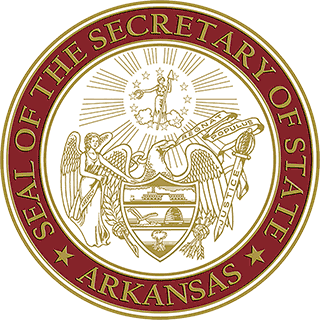Story of the Flag
The Story of the Arkansas Flag
Can you imagine Arkansas’ flag with an ocean steamer or a dancing bear? Instead of the handsome and dignified red flag centered with a diamond and stars, such flags could have flown over the twenty-fifth state if a 1913 committee had not acted with wisdom.
The battleship U.S.S. Arkansas was to be commissioned and the Pine Bluff chapter of the Daughters of the American Revolution voted to present a state flag to the ship. But first, the flag committee of the chapter had to learn about the state flag. A letter to Secretary of State Earl W. Hodges was sent by a committee of three, Mrs. C.W. Pettigrew (whose idea it was in the first place), Mrs. W.A. Taggart and Mrs. Frank Tomlinson. Before long they had the answer: there was no state flag.
The Pine Bluff group decided to correct the situation by holding a statewide flag contest. Mr. Hodges was asked to act as custodian for entries. Sixty-five separate designs were entered in the contest. Some were crayon drawings and some were flag miniatures on silk.
As the state flower, the apple blossom appeared on a number of designs. One centered with the flower was scattered with stas representing the United States. There were thirteen rays on it for the original states and the colors were red, white and blue. One flag used just the apple blossom, four of them in colorful blocks. Another design used the outline of Arkansas and the state seal with red, white and blue.
Mr. Hodges was chairman of the committee to select the flag and he chose a distinguished list of members: Dr. Junius Jordan, the chairman of philosophy and pedagogy at the University of Arkansas; Mrs. Julia McAlmont Noel, a member of the John McAlmont Chapter of the D.A.R. in Pine Bluff; Miss Julia Warner, a teacher in the Little Rock school system, and Mrs. P. H. Ellsworth, a former president of the Arkansas Federation of Women’s Clubs.
In the early days of 1913 the committee gathered in Mr. Hodges’ office and worked on choosing a flag. As a winner they chose the red, white and blue design of Miss Willie Hocker of Wabbaseka, a member of the Pine Bluff chapter of the D.A.R., where the search originated.
On a rectangular field of red, Miss Hocker had placed a large white diamond bordered by twenty-five white stars on a blue band. Three blue stars in a straight line were centered in the diamond.
Miss Hocker explained that the colors in her design meant that Arkansas was one of the United States of America. The three blue stars had three meanings: Arkansas belonged to three countries (France, Spain, and the United States) before attaining statehood; 1803 was the year of the Louisiana Purchase when the land that is now Arkansas was acquired by the United States; and Arkansas was the third state created from the purchase by the United States, after Louisiana and Missouri.
The twenty-five stars mean that Arkansas was the twenty-fifth state to be admitted to the Union. The diamond represents Arkansas as the nation’s first diamond-producing state.The two parallel white stars at the left and right points of the diamond symbolize the dual admission of Arkansas and Michigan to the Union. Both were admitted to the Union about the same time-Arkansas on June 15, 1836, and Michigan on January 26, 1837.
On February 26, 1913, the legislature made Miss Hocker’s design the state’s official flag. The U.S.S. Arkansas received her flag from the Pine Bluff Chapter of the D.A.R.
Then there was trouble...there was no indication on the flag that Arkansas had been a member of the Confederate States of America from 1861 to 1865. To correct that, the legislature in 1923 added a fourth blue star above the letter “R” in Arkansas and moved the single blue star to a position above the last “A”. But, a furor arose and many claimed that the original symmetry and meaning of the design were destroyed.
So in 1924 the legislature placed three blue stars below the word “Arkansas” and one above, the way the flag is today.
The three stars below “Arkansas” retained the meanings Miss Hocker had set and the lone star above the word is to commemorate Arkansas’ membership in the Confederacy.
And so it remains today...a proud banner that flies for all Arkansans.



